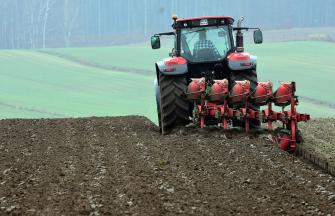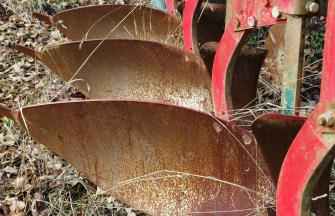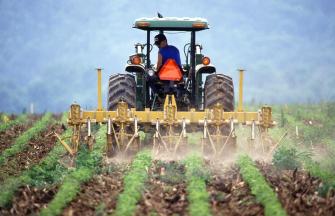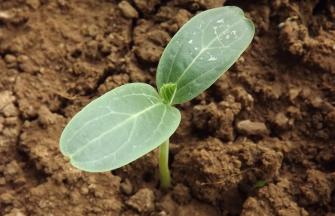
Agricultural lime: an introduction
Farmers have been using lime to improve the quality of their soils for generations. But what exactly is agricultural limestone (or ag lime), and how does it do what it does? In this article, we will strap on our boots and follow in the footsteps of farmers past and present on a walk through the fascinating world of agricultural lime, calcium carbonate, and more.
What is Ag Lime?
This may seem a simple question, but it is not without its complications. To some extent, the answer actually depends on where you are asking the question. In the EU, for example, agricultural lime tends to be quicklime (CaO). However, this article will focus on North American usage, where the form of lime used in agricultural applications tends to be high-purity, chemical-grade, pulverized limestone.
But here again, we run into some trouble with our definition. Because as any aspiring geologist will tell you, limestone is a general term that covers a range of rocks with slightly different chemical compositions. The common factor is the presence of carbonate minerals: either calcite (CaCO3) or dolomite (CaMg[CO3]2). Both can be used in agricultural applications.
Types of ag lime
Limestone
Generally speaking, there are two categories of agricultural lime: high-calcium lime and dolomitic lime. As the names suggest, the two types of agricultural lime reflect the mineral composition of the limestone used in their production. High-calcium (or hi-cal) lime is derived from limestone deposits that are almost entirely pure calcite. Dolomitic lime, on the other hand, contains both calcite and magnesium carbonate (MgCO3) in varying ratios.
Hi-cal and dolomitic lime both have similar effects on the soil (more on this below), which is why both are used in agricultural lime applications. Dolomitic lime will react more slowly, but the end result is ultimately the same. The most common determining factor when choosing between the two is therefore likely to be cost.
Not so fast, however: There are some other factors that may be involved in the decision, notably soil composition. In fields that are magnesium deficient, for example, dolomitic lime may be the preferred option. Conversely, in fields with higher magnesium levels, the use of hi-cal lime will avoid adding more. To add an extra layer to deliberations, the ideal soil composition will depend on what crops are being grown there. Testing your soil is therefore an important part of planning an agricultural lime application (we discuss soil testing in more detail below).
Before moving on, a brief word on other forms of lime that can be used to amend soil. As mentioned above, quicklime is popular in the EU, but it is harsher than limestone and must be appropriately managed to avoid burning the fields. Hydrated lime (either as a dry product or as a slurry) is another option, with the latter (also called milk of lime, liquid lime, or slaked lime) in particular being easier to spread evenly on the field. Liquid lime products are actually minority products in the North American agricultural lime market. Slaked lime products have their benefits and drawbacks, but thankfully, many different pulverized limestone products are available.
Other sources: lime sand and chalk lime
While limestone is the basis for the agricultural lime used in North America, a couple of other forms are used internally and merit a short mention here. Lime sand is sourced from mining coastal sand dunes, for example, the coast of Western Australia, where significant quantities are used in the state’s inland Wheatbelt region. Mostly comprising shell and coral fragments, lime sand is mostly calcitic but can also contain some magnesium carbonate.
As the name suggests, chalk lime contains chalk rather than limestone. Although both types of rock share similar chemical compositions (chalk also being mostly CaCO3), chalk is less densely compacted and therefore softer than limestone. And with different benefits available than what liquid lime offers, chalk lime is more easily broken down and absorbed by agricultural and garden soil.
The Benefits of Ag Lime
Improves a soil's pH level
Productive agriculture will naturally result in the acidification of the soil, as alkaline products (in the form of crops) are removed. As the acidic soil becomes even more acidic over time, its productivity will drop. This makes rebalancing acidic soil’s pH levels a critical element in maintaining crop yield - which is where applying agricultural lime comes into play. As a naturally-occurring alkali (base) material, lime acts as a safe and effective means of raising soil pH.
To take a deeper dive into the chemistry, many of the benefits of agricultural lime are that it releases calcium and magnesium cations (Ca++ and Mg++) into the soil, which replace hydrogen cations (H+). As calcium and magnesium cations are both basic, while hydrogen cations are acidic, this exchange effectively increases the alkalinity of the soil. But it also explains the next benefit of agricultural lime.
Provides calcium and magnesium
By now, this may be clear: spreading agricultural lime on a field will replenish the calcium and magnesium nutrients that are taken up in the process of growing crops.
Improves plant structure/strengthens root systems
This relates back to soil pH levels, as - generally speaking - the more acidic soil is, the more plant growth will be hindered (an example of an exception are blueberries, which grow best in soils with pH levels of about 4.5). Rebalancing pH levels reduces the toxicity of the soil to plant growth and therefore promotes the development of healthier root systems, particularly in younger, more vulnerable plants.
This in turn helps to increase the plant’s nutrient uptake, resulting in an overall plant structure that is healthier and stronger — and more productive.
On a related note, in leguminous crops, such as beans, alfalfa and peas, agricultural lime helps improve nitrogen fixation, whereby colonies of bacteria living in the roots convert atmospheric nitrogen into the nitrates needed by plants to grow. These bacteria - rhizobia - are essential to healthy and productive legume crops and thrive in more basic soils, such as can be achieved by the addition of agricultural lime.
Rhizobia are also not the only bacteria that enjoy higher-pH soil. Raising soil pH levels promotes microbial activity in general, leading to greater decomposition of organic matter in the soil, and thus the availability of key nutrients.
Finally, on a more mechanical note, the addition of agricultural lime will result in a more friable soil, enabling deeper root growth and better drainage conditions - a particular benefit when dealing with plastic (clay) soils.
Improves fertilizer/herbicide efficiency
A final benefit of raising the pH levels of acidic soil relates to the use of fertilizers and herbicides. The efficiency of these is inhibited by soil acidity; higher pH levels therefore optimize the impact of both. This not only improves plant health, but means less of these chemicals are required to achieve the desired effect, which reduces the risk of overuse and toxic soil run-off into surrounding bodies of water.
Finding the right ag lime
Having dealt with what agricultural lime is and why it is beneficial, it is time to ask the most practical question: when it comes to purchasing agricultural lime, what do you need to know?
Know your soil conditions: the importance of soil testing
Before you even begin to think about sourcing your lime, it is important to understand what is going on in your fields. Soil testing in a soil testing laboratory is easily available and provides a range of useful information, including the pH levels of a soil, and the levels of various essential nutrients, such as calcium, magnesium, phosphate and potassium, among others. It also helps to know the type of soil you are farming in, whether clay, loam or sand.
With the information that can be gained from the soil testing laboratory, you can most effectively plan your use of agricultural lime. In general, the higher the soil acidity, the more agricultural lime you will need to neutralize it. Meanwhile, clayey soils retard the effectiveness of liming materials and will therefore require higher dosage rates than sandier soils. And as mentioned above, your magnesium levels may be a factor if choosing between hi-cal (high calcium) or dolomitic lime products.
Knowing your soil conditions ensure you use the right amount of lime to achieve the soil conditions appropriate to your crops, promoting better plant growth and therefore increased yield. Yet farmers have traditionally relied on a “rule-of-thumb” approach to liming, spreading two tons of agricultural limestone per acre, every three to five years - and hoping for the best.
How do you assess the effectiveness of an ag lime?
Having dug into your soil conditions, it is time to look at the agricultural lime products available. The market is however awash with terms, which often differ between states (and even within states). Here is a helpful guide into some of the most important concepts.
Calcium Carbonate Equivalent (CCE)
CCE - also sometimes referred to as total neutralizing power (TNP) - is the most basic way of comparing the effectiveness of different agricultural limes. It compares the neutralizing value of a liming material with that of pure calcite (CaCO3). A CCE of 100% indicates liming materials with an equivalent neutralizing value as calcite. A higher value indicates the liming material is able to neutralize more acid per pound than calcite; a lower value, the reverse. CCE of common lime products are shown in the table below:
| Liming Material | Chemical Formula | Calcium Carbonate Equivalent (CCE) |
|---|---|---|
Pure High Calcium Limestone | CaCO3 | 100 |
| Pure Dolomitic Limestone | CaMg(CO3)2 | 109 |
| Hydrated Lime | Ca(OH)2 | 136 |
| Quicklime | CaO | 179 |
Sizing
Both effective neutralizing value (ENV) and effective neutralizing power (ENP) offer a more refined calculation of the effectiveness of an agricultural liming product than simple CCE. ENV also takes sizing into account. You can also divide the cost per ton of liming material by the ENV to calculate the cost effectiveness of a particular agricultural lime.
ENP takes moisture into account and expresses ENV as a dry weight to demonstrate the amount of actual neutralizing material you are purchasing.
Effective Neutralizing Value and Effective Neutralizing Power
Both effective neutralizing value (ENV) and effective neutralizing power (ENP) offer a more refined calculation of the effectiveness of an agricultural liming product than simple CCE. ENV also takes sizing into account. You can also divide the cost per ton of liming material by the ENV to calculate the cost effectiveness of a particular agricultural lime.
ENP takes moisture into account and expresses ENV as a dry weight to demonstrate the amount of actual neutralizing material you are purchasing.
Putting it all together
When it comes to choosing your agricultural lime, here are the top take-aways:
- The right agricultural lime will vary on application. It could be hi-cal or dolomitic, depending on the existing magnesium content in the soil and what is available in your area.
- All quality agricultural lime products will, however, be characterized by:
- Relatively low moisture: you need some to facilitate spreading, but otherwise don’t want to be paying for more water than is necessary
- No oversize: ideally <40 mesh
- An ENP of >90
The final step: applying ag lime
Once the lime has been selected and delivered, it is time to spread it and let it do its work. For consistent results, lime should be distributed evenly across the field. The equipment used for applying agricultural lime will therefore vary depending on the characteristics of the lime:
- Drop-type spreaders are ideal for applying dry, fine agricultural liming materials, such as powdered lime.
- For applying moist or larger agricultural lime products (such as pelletized lime), spinner spreaders are the better choice.
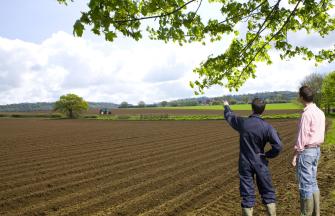
The end of the ag lime journey
With the spreading done, that wraps up our journey through the world of agricultural lime. But if you are interested in going further, you can check out our hi-cal agricultural lime products. Or connect with us directly to discover how we can help maximize your crop yield. With our team of experts based at the Carmeuse Innovation Center in Pittsburgh, we are ready to discuss your particular needs and help you get the most out of your agricultural lime.


